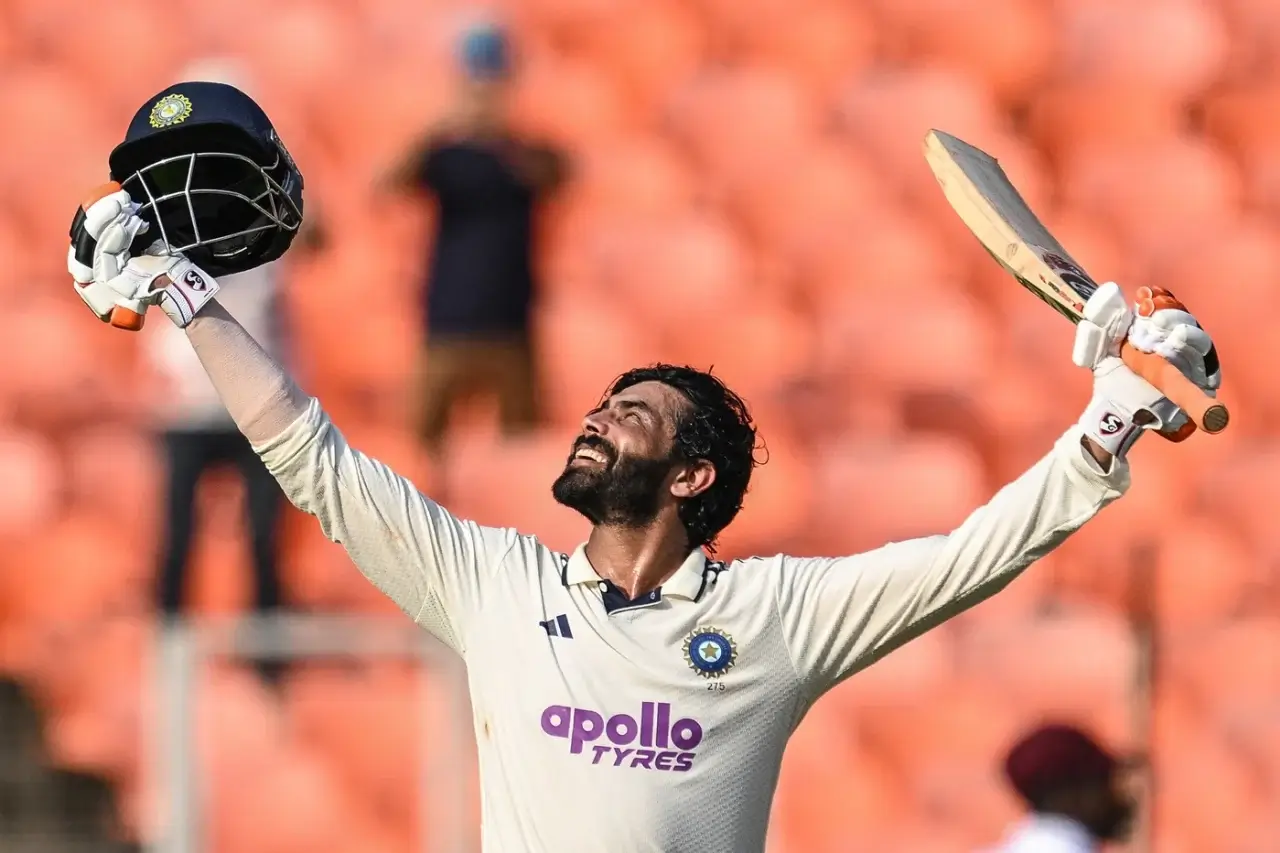Day three in Ahmedabad belonged to India’s batting masters and their patient discipline. KL Rahul, Dhruv Jurel, and Ravindra Jadeja all scored centuries to dominate. India piled on 327 runs for only three wickets across relentless batting control. Their lead stretched to 286, placing them firmly ahead in this first Test.
Rahul’s century carried emotional weight as it was his first at home since 2016. His calm shot-making mixed patience with controlled aggression against both seam and spin. Jurel marked his maiden hundred with style, showing confidence beyond his years at the crease. He batted with maturity, adapting well to tough phases and countering bowlers effectively.
Jadeja completed the centurion’s trio with an unbeaten 104 built on attacking intent. He attacked spinners ruthlessly, charging down and putting pressure on their lines consistently. His seven boundaries and a six showcased how aggression worked on a crumbling pitch. For West Indies, bowlers toiled hard but leaked runs and missed key opportunities.
Seales bowled with heart, creating chances but lacked consistent support from his fielders. Warrican and Chase extracted turn, but India’s approach nullified their impact successfully. The day’s story was not just runs but India’s ability to dictate terms. Ahmedabad witnessed a day where experience and youth combined perfectly to overpower visiting West Indies.
Day of Triple Hundreds: India’s Batting Depth in Full Control
India ended the third day on 448 for 5 with absolute dominance. Rahul’s hundred, Jurel’s maiden ton, and Jadeja’s unbeaten 104 all defined authority. The trio scored across sessions, rotating strike and punishing loose deliveries with ease. They added 327 runs for just three wickets, putting India in match-winning position.
Rahul’s innings survived an early edge that slipped through a misfielded cordon. From there he rebuilt, rotating the strike and waiting for poor deliveries. His composed batting gave India stability at the top of the order. Jurel’s century, meanwhile, showed patience, strong defence, and excellent judgment in testing conditions throughout.
Jadeja adopted a more aggressive approach, scoring 86 against spin with attacking footwork. His 41 off 15 deliveries included several boundaries that unsettled bowlers completely. He made sure India kept scoring quickly even as pitch conditions wore. The result was a West Indian attack that looked drained and defeated early.
Warrican, Chase, and Pierre combined for long spells but lacked sustained impact. Seales bowled tirelessly, reaching 140kph but missed vital support across long sessions. India’s batters stuck to a plan and controlled every partnership that developed. Their discipline allowed them to build partnerships and carry momentum throughout a decisive day.
West Indies struggle with discipline and missed opportunities
West Indies entered the day with run-saving strategies instead of taking wickets. Their field placements lacked attacking intent, giving India easier scoring opportunities throughout sessions. Seales produced Rahul’s edge early, but the absent first slip proved costly. That miss allowed Rahul to settle and extend the innings significantly for India.
Spinners bowled long spells, but India chose aggression to nullify their turn. Jadeja stepped down regularly, forcing bowlers away from their preferred lengths consistently. Jurel’s calmness against the second new ball reinforced India’s dominance even further. By the close, India held control while West Indies looked weary and uncertain.
How Dhruv Jurel Has Seized the Opportunity with Both Hands?
Dhruv Jurel’s first Test century underlined his calmness, patience, and technical strength. He scored 125 runs with a balance of defence and selective aggression. Against pace, he looked secure on the back foot, timing shots with ease. Against spin, his judgment of length allowed him to rotate strike effortlessly.
Jurel showed maturity when facing the second new ball late in the innings. His compact defence and shot selection highlighted why selectors trust his long-term value. His batting has been consistent across levels, and this innings added credibility. The celebration for his father, an army man, highlighted his grounding and focus.
With Rishabh Pant recovering, Jurel presents a unique option for team selection. His batting quality means India may even consider him as a specialist batter. This innings showed he can handle pressure and still build a match-defining knock. Jurel has now set a high standard for himself in Tests.
Selectors and coaches will see him as a valuable long-term investment across formats. His adaptability against spin and pace indicates potential to succeed abroad as well. His consistency creates security, a quality often missing in India’s middle order. This hundred could mark the start of Jurel’s long Test career with India.
Why Jurel’s performance builds trust for selectors?
Jurel has given India a reliable cushion in the middle order. His ability to bat long, defend tough balls, and counter-attack is valuable. Unlike flamboyant players, his style emphasizes judgment and composure under difficult match scenarios. This balance increases his chances of becoming a mainstay in India’s Test plans.
He now pushes competition with Pant, offering the team depth and stability. His focus on patience and strike rotation makes him dependable in long innings. Future overseas tours will test him, but this century gives confidence in his skills. India has discovered another reliable option who can contribute in critical match moments.
How Jadeja Earned Respect After England and Proved It at Home?
Ravindra Jadeja’s unbeaten 104 showed his value and his constant improvement as a batter. He attacked spinners when the pitch turned sharply, scoring 86 runs against them. His strategy of charging down disrupted their rhythm and forced them into defensive lengths. Seven boundaries and one six showcased how his intent shifted the game.
Analysts noted Jadeja’s improvement against pace during the England series earlier this year. He carried that confidence into this innings, handling seam and bounce effectively. This growth has changed how opponents view him, now as a complete batting threat. Jadeja’s ability to bat deep gives India both solidity and attacking flexibility.
His innings not only accelerated India’s scoring but lifted morale across the team. He connected his hundred to the trio of centuries, adding historical importance. India last saw three centurions in one home innings back in 2018. Jadeja ensured this occasion added to his growing stature as a dependable allrounder.
The respect Jadeja now commands is rooted in consistent improvements across formats. His batting matches his elite fielding and reliable spin bowling, making him vital. In home conditions, he can now anchor innings as well as accelerate. This adaptability strengthens India’s balance and gives selectors valuable flexibility across their plans.
Jadeja’s development as a batting allrounder
Jadeja’s progress with the bat is no longer just a supporting role. His ability to score freely under pressure makes him a senior batting option. Opposition teams now plan for him specifically instead of treating him as lower order. His innings against England, and now West Indies, have solidified that reputation.
Attacking spin with confidence shows his evolved approach and tactical maturity today. Coming down the track repeatedly was a decision backed by strong execution. His improved play against pace has also erased previous question marks about him. India now see Jadeja as a three-format player who adds value everywhere.
Is KL Rahul the New Version Providing Solidity in ODIs and Tests?
KL Rahul’s century in Ahmedabad ended a long wait for home success. His 100 was built on calmness, patience, and careful shot selection throughout. It was also special as he celebrated the milestone for his newborn. His innings symbolized maturity, and perhaps a turning point in his career revival.
Rahul benefited from an early reprieve when Seales found his outside edge. That moment changed his confidence and allowed him to build steadily without pressure. He rotated the strike effectively and absorbed spells from spinners with ease. His presence ensured India maintained balance and did not lose wickets in clusters.
Rahul’s value to India lies in his adaptability across formats like Tests and ODIs. He can build long innings, anchor a chase, or accelerate when required. This flexibility makes him a valuable option for selectors seeking consistency. His innings suggests he may embrace a stabilizer’s role in upcoming challenges.
Rahul’s leadership through calm batting can inspire younger teammates in the squad. His renewed confidence and steady form could redefine his role as senior batter. If consistent, Rahul may anchor India’s batting for both red-ball and white-ball. This hundred may be the start of his new version as India’s stabilizer.
Why Rahul’s innings matters for India’s batting future?
Rahul’s calmness under pressure has been a missing trait in recent Indian line-ups. His ability to balance attack and defence reduces collapse risks across formats significantly. ODI and Test cricket both benefit from such stabilizers in long match phases. This innings indicates Rahul may step into that much-needed leadership role now.
His growth adds another dependable pillar alongside Kohli and Rohit in ODIs. In Tests, he can build innings with Gill, easing middle order burden. Consistency is key, and selectors will watch whether Rahul sustains this level. For now, India’s batting depth looks strengthened by his timely and composed hundred.
Conclusion
India’s dominance on day three came through the combined force of three centurions. Rahul, Jurel, and Jadeja scripted innings that placed India far ahead comfortably. Each hundred carried its own story of patience, aggression, and controlled match management. Together, they reflected depth, balance, and intent in India’s batting arsenal.
Jurel announced himself with a maiden hundred marked by technique and composure. Jadeja confirmed his growth as a batting allrounder capable of turning matches quickly. Rahul rediscovered his touch and hinted at a role as India’s stabilizer. These three knocks showed India’s bench strength and senior players working in harmony.
West Indies struggled to contain runs and lacked attacking plans across the day. Their bowlers tried but could not challenge India’s positive approach consistently. India seized every opportunity and turned pressure into dominance at Ahmedabad’s iconic venue. The series opener now tilts heavily toward a quick Indian win this week.
For broader perspective, explore the India vs Bangladesh timeline for key historical parallels: https://cricketstadium.com.in/india-national-cricket-team-vs-bangladesh-national-cricket-team-timeline/
India must now manage declarations, rotations, and protect fitness for the next matches. This Test already sets a tone for the home season ahead strongly. Fans will cherish a day of three hundreds that defined India’s batting control.

















